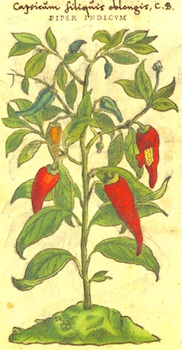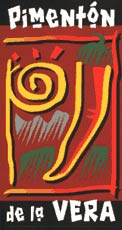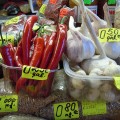Compiled by Dave DeWitt
“At the entrance of the market was planted a cohort of dealers in Paprika, who had sacks full of this red pepper, so violently pungent, that a little on the point of a knife was enough, to our taste, to spoil a dish, but of which astonishing quantities are eaten by the natives. In the hotels, all sorts of Paprika dishes are brought—Paprika beef, Paprika bacon, Paprika fish, &c.;—but among the common people the Paprika is so universally understood, that it is seldom mentioned. One might think that every thing in Hungary grew seasoned with Paprika, bread being the only exception. This plant is, I believe, the same as that called among us, Turkish or Indian pepper (Capsicum annuum); the kernel and the husk being ground up together for Papriki, both containing equally the fiery pungent quality.” Johann Georg Kohl, Austria: Vienna, Prague, Hungary, Bohemia, and the Danube. London: Chapman and Hall, 1844.
Note on Hungarian Red Pepper
In the discussion upon Mr. Greennish’s paper at the Pharmaceutical Conference at Swansea, I had occasion to mention the fact that a sample of cayenne might be a perfectly genuine powder of capsicum fruits and still possess relatively a very small degree of pungency; that it might be of a richer red tint than we are accustomed to see, and might produce a bright orange-coloured, oily looking stain on the paper in which it had been wrapped, without the admixture of anything in the shape of an adulterant. I named as an illustration the red pepper commonly met with in some parts of southern Europe, notably the paprika of the Hungarians, as well as some similar condiments used in Algeria, and elsewhere.
Finding that very little was known amongst those who took part in the discussion of any cayenne except the powder prepared from the fruit of Capsicum fastigiatum, I wrote to a scientific friend in Vienna for some particulars respecting the Hungarian product, and the information I have received in reply may possibly be of interest to the readers of the Journal. He states that paprika is prepared entirely from the fruit of Capsicum annuum, Linn., which is grown generally throughout Hungary. Of this species, however, there exist a great number of varieties, distinguished bv the size and shape of the fruits, and their milder or sharper flavour. The larger fruits ate as a rule comparatively mild, and have a sweetish taste of their own, whilst the small pointed sorts are commonly the more pungent. The degree of pungency, as well as the particular flavour is said to depend in part upon locality, and in part also upon method of cultivation.
The Szegediner paprika is the sort most esteemed by the Hungarians. Some specimens of this variety which have been sent to me resemble the large capsicums seen in our own markets, except that they are broad or truncate at the apex, instead of pointed. The pepper is ground with very little preliminary drying, hence there is considerable difficulty in keeping the powder. It is the custom to put it on the table in a salt-cellar, not in a cruet; but many Hungarian dishes are seasoned with it before being brought to table. I have sometimes had small parcels of paprika sent to me by post, but the experiment has not been very satisfactory; when fresh, it is an agreeable condiment, but if kept in an open vessel it becomes dry and tasteless, whilst in a closed one it soon turns mouldy.
Szeged is a town of some size, lying directly south of Pesth, perhaps half way to the Bosnian frontier. In connection with the subject it is interesting to note that the cultivation of the capsicum in this part of Europe dates back for three centuries. Fluckiger and Hanbury quote Leonard Fuchs, who states that “he saw it cultivated in abundance at Brünn, in Moravia, in 1585.” Moravia, it will be recollected, is the province of Austria adjoining Hungary on the north. The same authorities give it as their opinion that a considerable portion of the cayenne imported in powder is prepared from the fruits of Capsicum annuum. Henry B. Brady in The Pharmaceutical Journal and Transactions,Pharmaceutical Society of Great Britain. London: J. & A. Churchill., 1881.
Paprika and Cayenne
It would be remembered that at the Pharmaceutical Conference he brought forward a sample of cayenne which had been introduced into this country; not as was at first thought as an adulterant, but as afterwards appeared for the feeding of canaries, and Mr. Brady then suggested that it was probably the paprika which was grown in Hungary. Professor Dragendorff gave him a specimen of genuine paprika, sent him by Professor Egge, and it was a kind of cayenne which was in common table use in Russia, being used freely like ordinary pepper. It hail certainly a pungency which the specimen he showed at the Conference did not possess. Mr. Brady had since sent to Hungary for some paprika, and one sample possessed a little of “the pungency of cayenne, but the other specimen did not. It was quite possible that the sample he showed might have been of the latter kind, as it had a good colour. “Minutes of Pharmaceutical Meeting.” The Pharmaceutical Journal and Transactions, Pharmaceutical Society of Great Britain. London: J. & A. Churchill, 1881.
Gulyas with the “National Product”
Peculiar, wondrously appetizing odors of the kitchen greet our nostrils, for we are here on the classical soil of the Hungarian “gulyas,” which the Viennese pronounce “gollasch,” and the Hungarians “gujaasch.” What is, then, a “gulyas”? Meat roasted in a peppery onion sauce. But what a stupid definition that is! It is like saying that an opera by Mozart is a combination of sounds. One thing, however, is beyond dispute—if there is a Hungarian heaven, “gulyas” is sure to be eaten there. “Gulyas,” then, is a concoction of onions, pork, meats of all sorts, and paprika (red Hungarian pepper). But who can praise in fitting language its savoriness? Who can describe with adequate eloquence the blood-and-marrow-penetrating strength of the paprika, this boasted national product? Who can praise sufficiently the pungent pepper with which the “gulyas” is seasoned in such abundant measure that the stranger who eats it feels something dissolve inside of him? Stars dance before his eyes, and the perspiration breaks out upon his brow. But this excessive pungency is tempered and enriched by the potatoes cooked into a mealy liquid and the little dumplings known as “nokerel.” In “gulyas,” as in music, there are infinite variations possible, but the key-note is always the paprika. With the “gulyas,” one or more bottles of fiery Hungarian wine are drunk. Ho, ho! Hungarian Eljen! Wilhelm Singer, “Popular Life in the Austro-Hungarian Capitals,” Harper’s Magazine, Volume 84. New York: Harper’s Magazine Co., 1892.
The Best Paprika
Paprika, the sharpest of table condiments, is the selected and especially prepared part of red pepper, as made in Hungary. The red pepper is there ground in stone mills, specially constructed for the purpose, having shakers and sieves attached for assorting the  ground product. For the best (rose paprika) only the choicest and most perfectly dried fruit is used, which must first be carefully cleaned and cleared of the larger seeds; and its preparation requires much knowledge and skill. The damaged fruit and the rejected parings are more hastily ground, and sold as ordinary pepper. Ernest Ingersoll, “Recent Progress in Science,” Frank Leslie’s Popular Monthly, Volume 41, New York: Frank Leslie Pub. House, 1896.
ground product. For the best (rose paprika) only the choicest and most perfectly dried fruit is used, which must first be carefully cleaned and cleared of the larger seeds; and its preparation requires much knowledge and skill. The damaged fruit and the rejected parings are more hastily ground, and sold as ordinary pepper. Ernest Ingersoll, “Recent Progress in Science,” Frank Leslie’s Popular Monthly, Volume 41, New York: Frank Leslie Pub. House, 1896.
Hungarian Chicken or Paprika Huhn
Put one heaped tablespoonful butter or dripping in a tight stew pan, add two good-sized onions sliced thin and left in long strips. When slightly colored, add half teaspoonful of Hungarian pepper or paprika and mix well and let them brown. Then add the chicken cut in pieces and salted and peppered. Brown well, turning often. Then add stock or water till nearly covered. Stew until tender. Just before serving take out the meat, put on a hot platter, and add a full half cup or more of thick sour cream. Just let it scald but do not boil it, pour it over the chicken and serve at once.* The American Kitchen Magazine, Volume 6. Boston: Home Science Pub. Co., 1897.
*A half-teaspoon of paprika is just not enough to flavor a whole chicken. More like 1/4 cup would be necessary. (Ed. Note)









